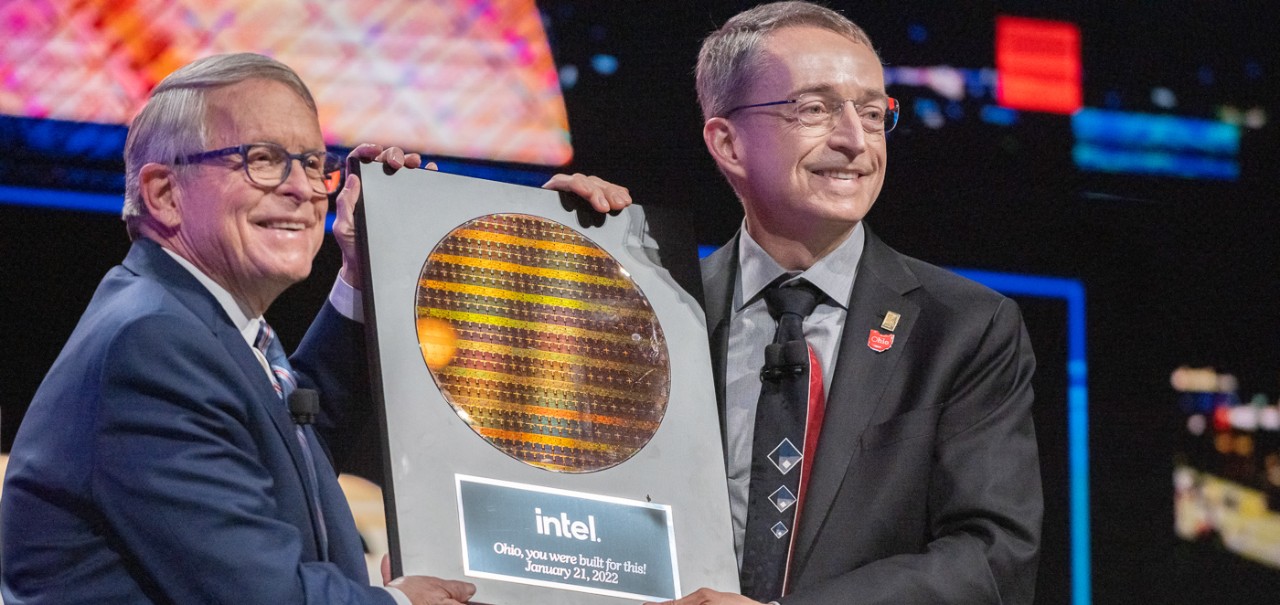
Co-op launched UC alumnus’ Intel career
It has never been a better time to be a computer engineer, Intel exec says
Intel Corp.’s new semiconductor fabrication plants outside Columbus will provide new research and career opportunities for Ohio’s engineering students and faculty in what has been called the largest private investment in state history.
University of Cincinnati students for years have benefitted from an affiliation with the company. Intel has been a springboard to success for Bearcats for much of the company’s 54-year history. Intel has seeded the careers of many UC alumni in fields as diverse as physics, computer engineering and computer science.

James Breisch
James Breisch was introduced to Intel through his first co-op in UC’s College of Engineering and Applied Science while earning a bachelor’s degree in electrical engineering and computer science.
Today, Breisch (class of ’93) is vice president of the Design Engineering Group at Intel in Chandler, Arizona. His wife, Patty, graduated from UC’s Lindner College of Business and works in human resources at Intel. They met as undergraduates at UC. Today, they have two children, both pursuing computer science careers.
“I loved the UC campus on my college tour. I grew up in Dayton and it was close enough to home,” Breisch said. “The co-op program was one of the key reasons I came to UC. That was a selling point for me.”
UC created the nation’s first cooperative education program in 1906 in which students dedicate part of the year to full-time academic instruction and part of the year to full-time employment with any of more than 2,000 business partners around the world.
I think what I learned working and studying at UC directly contributed to my success.
James Breisch, Intel Corp.
UC’s co-op model has been replicated across the globe, but UC maintains its standing as a national leader (fourth in co-op in the latest rankings by U.S. News & World Report.)
Breisch drove cross-country to Arizona to start his co-op. It was an exciting time of his life, he said.
“I got hired by another UC alumnus,” Breisch said. “It gave me a good taste for the types of technology that Intel was building. I used it as a jumping-off point for my career.”
Given his family’s ties to aerospace engineering, one might assume Breisch’s career would take a different path. After all, his father was a pilot and he grew up in the shadow of the Wright-Patterson Air Force Base surrounded by aviation and aerospace professionals.
“Aerospace engineering was something I felt I had good exposure to and an intuitive understanding of how it worked,” he said. “But electrical and computer engineering was like magic to me. I didn’t understand how it worked. That’s what enticed me and pulled me in.”
When he received an Apple IIe computer, released in 1983, he never looked back.
“I spent hours on it every day teaching myself to program, making games,” he said.
Breisch worked three co-op rotations at Intel. He even pushed back his graduation six months so that he could help his team finish a project as its only circuit designer. Intel invited him to stay with the company after graduation.
“At first I was doing small-circuit design work, then SRAM and Flash memory design,” he said. “From there I moved to a new team designing digital cameras and digital imaging chips.”
Breisch had a chance to work on CMOS imaging sensors found in digital cameras and cell phones.
“This was when almost everyone in the world was still using film cameras,” he said.
For the last 15 years, he has led teams designing Intel’s cutting-edge microchips used in notebook, desktop and server computers.

Intel Corp. announced it will open two new semiconductor fabrication plants outside Columbus as part of an estimated $20 billion investment in Ohio. Photo/Brian Kostiuk/Unsplash
Breisch said the biggest change he has seen in his career has been to the microchip.
“The increases in complexity are exponential. When I started, you could have a chip with paper schematics and understand all of them — maybe 30 or 40 pages of schematics,” he said. “That’s completely impossible now.”
And microchips have become a ubiquitous part of daily life in a way he never imagined, Breisch said.
“It has exploded. They’re everywhere: notebook and desktop computers, of course; in communication networks; e-commerce; medical and financial infrastructure. They’re also in cars and cell phones to the simplest appliances and even some lightbulbs.”
Intel’s multi-year construction project in Ohio represents the biggest private investment in the history of the state, offering the promise of new high-tech jobs for thousands of workers. In March the company pledged $100 million for semiconductor education and research, half of which will go to colleges and universities such as UC. The National Science Foundation has offered $50 million more in grants to give workers technical training.
“It’s a win for Intel because of the quality of employees they will get,” Ohio Gov. Mike DeWine said at the March announcement. “It’s a win for students. It’s also a win for colleges and universities. This relationship with an amazing company like Intel will make a difference for colleges and universities around the state.”
Breisch said Intel’s expansion reflects the ongoing promise of computer engineering.
“The trend isn’t going away. It continues to be extremely exciting. It’s a fast-moving, ever-evolving industry,” he said. “And you never get tired of your job.”
Breisch said his time at UC gave him both the education and skills he needed as well as the connections to take advantage of them.
“I think what I learned working and studying at UC directly contributed to my success,” he said.
“The experience at UC prepared me for the real world. I really appreciated it,” he said. “My co-op landed me at a fantastic company to work for. Intel takes care of people and has high standards. I feel respected and appreciated as an employee.
“It has never been a better time to be a computer engineer.”
Featured image at top: Intel CEO Pat Gelsinger, right, presents a plaque to Ohio Gov. Mike DeWine during the company's announcement of its investment in two new fabrication plants in Ohio. Photo/Walden Kirsch/Intel Corp.
Next Lives Here
The University of Cincinnati is leading public urban universities into a new era of innovation and impact. Our faculty, staff and students are saving lives, changing outcomes and bending the future in our city's direction. Next Lives Here.
Related Stories
Cold-blooded and they make great friends
March 13, 2025
First-year student Josh Lantz starts a Herpetology Club at the University of Cincinnati.
UC Day of Giving connects Bearcats across the globe
Event: April 8, 2025 12:00 PM
For 24 hours on April 8-9, this celebration underscores the profound impact of philanthropy and its ability to transform the UC and UC Health community.
Biomedical engineer studying blunt and blast brain injuries
March 11, 2025
Olga Liaudanskaya, assistant professor of biomedical engineering at the University of Cincinnati, always dreamed of being a scientist. After finishing her graduate degree in materials science and engineering in Italy, she came to the United States for her postdoctoral program, where her research focused on the brain. This led her to a faculty position at UC’s College of Engineering and Applied Science. Recently, she was awarded funding from the Department of Defense for a project on the molecular mechanisms triggered by blunt and blast brain injuries.
